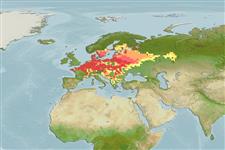Classification / Names
Noms communs | Synonymes | Catalog of Fishes (gen., sp.) | ITIS | CoL | WoRMS | Cloffa
Environnement / Climat / Gamme
Écologie
; eau douce; saumâtre démersal; potamodrome (Ref. 51243). Temperate; 4°C - 25°C (Ref. 1672), preferred ?; 62°N - 42°N, 15°E - 61°E
Europe and Asia: In Europe, north of the Alps, from Meuse eastward to Neva drainages and Lake Ladoga; northern Black Sea basin from Danube eastward to Kuban, absent on the southern section; Caspian basin in Volga and Ural drainages. Not native to Great Britain, Scandinavia, Apennine and Iberian peninsulas, Crimea, and Adriatic, Aegean and White Sea basins. Locally introduced in Rhône drainage (France) and perhaps elsewhere (Ref. 59043).
In Appendix III of the Bern Convention (protected fauna) (Ref. 1441).
Length at first maturity / Taille / Poids / Âge
Maturity: Lm ?, range 11 - ? cm
Max length : 30.0 cm TL mâle / non sexé; (Ref. 556); 30.7 cm TL (female); common length : 15.0 cm TL mâle / non sexé; (Ref. 556)
Description synthétique
Morphologie | Morphométrie
Épines dorsales (Total): 3; Rayons mous dorsaux (Total): 5-6; Épines anales 3; Rayons mous anaux: 8 - 11; Vertèbres: 49 - 50. Broad midlateral stripe from eye to caudal base and narrow stripe from opercle at least to pelvic origin. Lamina circularis absent in males (Ref. 59043). Caudal fin with 14-16 rays (Ref. 40476).
Found in lower reaches of slow-flowing rivers, but can also be found in still pools (Ref. 9696), on sandy bottoms of ponds, pools and ditches. Adults are nocturnal which burrow into mud during dry periods and strong frosts. Usually, burrows are 20-30 cm deep, occasionally down to 70 cm during dry periods (Ref. 59043). During the day, they stay buried in the sand. Feed on insect larvae and small mollusks. Seldom captured with hook and line (Ref. 30578). Are sensitive to pollutants which accumulate in the sediment (Ref. 11941). Facultative air-breathers (Ref. 27368). A female specimen measuring 30.7 cm TL was recorded from Netherlands (Ref. 114650).
Male follows female into dense vegetation and forms a complete ring around her body, behind dorsal fin (Ref. 59043).
Kottelat, M. and J. Freyhof, 2007. Handbook of European freshwater fishes. Publications Kottelat, Cornol and Freyhof, Berlin. 646 pp. (Ref. 59043)
Statut dans la liste rouge de l'IUCN (Ref. 115185)
CITES (Ref. 94142)
Not Evaluated
Menace pour l'homme
Harmless
Utilisations par l'homme
Pêcheries: sans intérêt; appât: usually
Plus d'informations
RéférencesAquacultureProfil d'aquacultureSouchesGénétiqueFréquences alléliquesHéritabilitéPathologiesTraitementMass conversion
Outils
Articles particuliers
Télécharger en XML
Sources Internet
